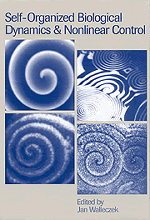 Self-Organized Biological Dynamics and Nonlinear Control
Self-Organized Biological Dynamics and Nonlinear Control Book contents
- Frontmatter
- Contents
- List of contributors
- Preface
- The frontiers and challenges of biodynamics research
- Part I Nonlinear dynamics in biology and response to stimuli
- 1 External signals and internal oscillation dynamics: principal aspects and response of stimulated rhythmic processes
- 2 Nonlinear dynamics in biochemical and biophysical systems: from enzyme kinetics to epilepsy
- 3 Fractal mechanisms in neuronal control: human heartbeat and gait dynamics in health and disease
- 4 Self-organizing dynamics in human sensorimotor coordination and perception
- 5 Signal processing by biochemical reaction networks
- Part II Nonlinear sensitivity of biological systems to electromagnetic stimuli
- Part III Stochastic noise-induced dynamics and transport in biological systems
- Part IV Nonlinear control of biological and other excitable systems
- Index
2 - Nonlinear dynamics in biochemical and biophysical systems: from enzyme kinetics to epilepsy
Published online by Cambridge University Press: 14 August 2009
- Frontmatter
- Contents
- List of contributors
- Preface
- The frontiers and challenges of biodynamics research
- Part I Nonlinear dynamics in biology and response to stimuli
- 1 External signals and internal oscillation dynamics: principal aspects and response of stimulated rhythmic processes
- 2 Nonlinear dynamics in biochemical and biophysical systems: from enzyme kinetics to epilepsy
- 3 Fractal mechanisms in neuronal control: human heartbeat and gait dynamics in health and disease
- 4 Self-organizing dynamics in human sensorimotor coordination and perception
- 5 Signal processing by biochemical reaction networks
- Part II Nonlinear sensitivity of biological systems to electromagnetic stimuli
- Part III Stochastic noise-induced dynamics and transport in biological systems
- Part IV Nonlinear control of biological and other excitable systems
- Index
Summary
Introduction
Biological systems provide many examples of well-studied, self-organized nonlinear dynamical behavior including biochemical oscillations, cellular or tissue-level oscillations or even dynamical diseases (Goldbeter, 1996). The latter include such phenomena as cardiac arrhythmias, Parkinson's disease and epilepsy. Part of the reason for progress in understanding these phenomena has been the willingness of investigators to communicate and share insights across disciplinary boundaries, even when this communication is hampered by differing jargon or concepts unfamiliar to the nonexpert. The common language of nonlinear systems theory has helped to facilitate this cross-disciplinary conversation as well as to provide a new definition of what it means to say that two things are dynamically ‘similar’ or even ‘the same’.
In this chapter, we compare the dynamics of a well-studied biochemical oscillator, the peroxidase-oxidase reaction, with that of epilepsy, a dynamical disease (Milton and Black, 1995). We are so accustomed to the normal way of reasoning in science that it seems wrong, somehow, to point out the similarities between, on the one hand, the oscillations in substrate concentration during an enzyme-catalyzed reaction and, on the other, the regular oscillations in the electroencephalography (EEG) signal observed during certain types of epileptic seizure. While these two systems could not be more different in terms of their material nature, they are actually quite similar dynamically.
- Type
- Chapter
- Information
- Self-Organized Biological Dynamics and Nonlinear ControlToward Understanding Complexity, Chaos and Emergent Function in Living Systems, pp. 44 - 65Publisher: Cambridge University PressPrint publication year: 2000
- 1
- Cited by


